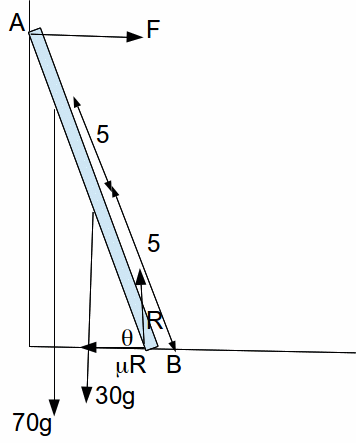Unfortunately, a ladder is most likely to slip when the climber is at the top. This is because the moment of the climber in the direction in which the ladder would slip is at its maximum when the climber is at the top. We can analyse the forces on a ladder as it leans against the wall to find any one of
The maximum distance up the ladder the climber can ascend
The minimum value of the coefficient of friction which will stop the ladder from slipping when the climber is at the top
The least horizontal force which must be exerted at the base of the ladder to stop it from slipping
The least angle that the ladder can make with the horizontal while not slipping
To analyse the first two, Suppose a ladder of mass 30 kg and length 10m leans against a smooth wall (so the reaction force at the wall is normal to the wall). The ladder makes an angle![]() with the horizontal, and a man of mass 70 kg climbs the ladder. If the coefficient of friction between the ladder and the ground is
with the horizontal, and a man of mass 70 kg climbs the ladder. If the coefficient of friction between the ladder and the ground is![]() find the maximum distance up the ladder the man can climb.
find the maximum distance up the ladder the man can climb.

When the ladder is just about to slip the force of friction at the ground is equal to![]() where
where![]() is the normal reaction force.
is the normal reaction force.
Resolving vertically for the ladder:![]()
The force of limiting friction is then![]()
Resolving horizontally for the ladder gives![]()
Now take moments about B. For the ladder not to slip,
![]()
so![]()
If![]() then the climber can get to the top so
then the climber can get to the top so![]()
